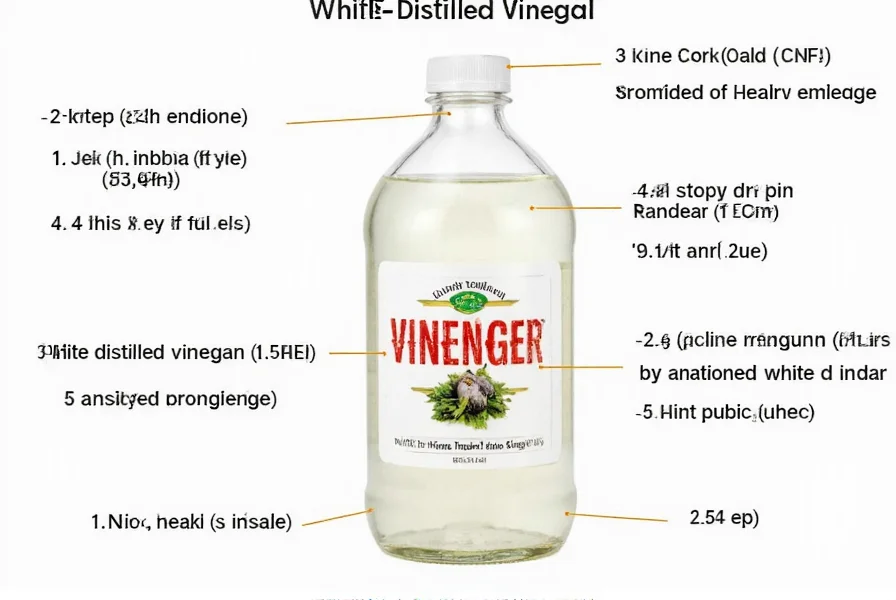Understanding the pH of white distilled vinegar provides valuable insight into its chemical properties and practical applications. This common household item's acidity level directly impacts its effectiveness for cooking, cleaning, food preservation, and even certain health applications when used appropriately.
What pH Means for White Distilled Vinegar
pH measures how acidic or alkaline a substance is on a scale from 0 to 14. White distilled vinegar's pH of 2.4-3.4 places it firmly in the acidic range, with lower numbers indicating stronger acidity. For reference, battery acid measures around pH 1, while black coffee sits around pH 5.
The specific pH of vinegar depends primarily on its acetic acid concentration. Most commercial white distilled vinegars contain 5% acetic acid, which corresponds to a pH of approximately 2.5. Higher concentration vinegars (like cleaning-strength 10% solutions) will have even lower pH values, approaching 2.0.
Measuring Vinegar Acidity Accurately
While pH indicates acidity strength, it's different from measuring acetic acid percentage. The acetic acid content (typically 5% for standard white vinegar) determines the potential acidity, while pH measures the actual hydrogen ion concentration in solution.
Several factors affect vinegar's measurable pH:
- Dilution with water raises pH (makes it less acidic)
- Temperature variations can slightly alter readings
- Presence of other compounds in flavored or artisanal vinegars
- Mineral content in the water used during production
| Common Household Substances | pH Range | Relative Acidity |
|---|---|---|
| Battery Acid | 0.5-1 | Extremely High |
| Gastric Acid | 1.5-3.5 | Very High |
| White Distilled Vinegar | 2.4-3.4 | High |
| Orange Juice | 3.3-4.2 | Moderate |
| Black Coffee | 4.8-5.1 | Mild |
| Pure Water | 7.0 | Neutral |
Practical Applications of Vinegar's Acidity
The specific pH range of white distilled vinegar makes it uniquely valuable for multiple purposes. In food preservation, this acidity level effectively inhibits bacterial growth, which is why it's essential for safe canning and pickling. The white vinegar acidity level for canning must be sufficient to create an environment where harmful microorganisms cannot survive.
For household cleaning, the distilled vinegar ph for cleaning provides enough acidity to dissolve mineral deposits, cut through grease, and eliminate certain stains without the harshness of stronger acids. Its effectiveness against limescale and soap scum directly relates to its pH level.
Chefs rely on understanding what is the ph of white vinegar when balancing flavors in recipes. The acidity interacts with other ingredients, affecting texture, preservation, and taste development in everything from salad dressings to baked goods.
Factors That Affect Vinegar's pH
While standard white distilled vinegar maintains a consistent pH range, several factors can cause minor variations:
- Dilution - Adding water increases pH (makes it less acidic)
- Temperature - Warmer temperatures can slightly lower pH readings
- Storage conditions - Exposure to light or air may cause minimal changes over time
- Manufacturing process - Different distillation methods yield slightly different purity levels
It's important to note that is white vinegar acidic enough for pickling depends on maintaining the proper acidity level. For food safety in home canning, the USDA recommends using vinegar with at least 5% acidity (approximately pH 2.6).
Safety Considerations with Acidic Substances
While white distilled vinegar is safe for culinary and household use at standard concentrations, its low pH means it should be handled with care in certain situations:
- Never mix with bleach (creates toxic chlorine gas)
- Dilute for skin applications to avoid irritation
- Use gloves when cleaning with undiluted vinegar for extended periods
- Rinse surfaces after cleaning to prevent potential damage to certain materials
The white distilled vinegar ph safety profile is excellent for normal household use, but understanding its chemical properties helps prevent misuse. Its acidity makes it incompatible with certain surfaces like marble, limestone, or waxed wood, where it can cause etching or damage over time.
Measuring Vinegar pH at Home
While laboratory-grade pH meters provide the most accurate readings, home users can estimate vinegar acidity using:
- pH test strips (litmus paper) designed for acidic ranges
- Red cabbage indicator solution (changes color based on pH)
- Digital pH meters calibrated for acidic solutions
For precise measurements, especially for food preservation purposes, investing in a quality pH meter that can accurately measure in the 2-4 range is recommended. Regular calibration ensures reliable readings for testing white vinegar ph at home.
Conclusion
White distilled vinegar's pH of 2.4-3.4 represents a carefully balanced acidity that makes it remarkably versatile for culinary, cleaning, and preservation applications. Understanding this specific measurement helps users apply vinegar more effectively and safely in various contexts. Whether you're using white vinegar ph for cleaning tough stains or relying on its acidity for safe food preservation, knowing the precise pH range provides valuable insight for optimal results.











 浙公网安备
33010002000092号
浙公网安备
33010002000092号 浙B2-20120091-4
浙B2-20120091-4